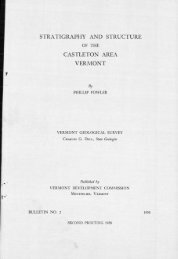Mineral Industries and Geology of Certain Areas - Vermont Agency ...
Mineral Industries and Geology of Certain Areas - Vermont Agency ...
Mineral Industries and Geology of Certain Areas - Vermont Agency ...
Create successful ePaper yourself
Turn your PDF publications into a flip-book with our unique Google optimized e-Paper software.
REPORT OF THE VERMONT STATE GEOLOGIST. 37<br />
Geological Survey, visited the locality in 1901, <strong>and</strong> his report is<br />
published in <strong>Mineral</strong> Resources <strong>of</strong> the United States. From<br />
this report the following is taken:<br />
Just to the south <strong>of</strong> the excavation made by the National<br />
Asbestos Company an important fault is visible, which strikes<br />
into the mountain in a direction 15 ° west <strong>of</strong> north, according<br />
to magnetic compass, but since local attraction sometimes appears<br />
in this region, the observation may not be exact. At all<br />
events, the fault brings the hornblendic or chloritic schist<br />
abruptly against the serpentine, <strong>and</strong> cuts <strong>of</strong>f the latter from<br />
extending farther to the west. Several feet <strong>of</strong> fault breccia<br />
mark the location <strong>of</strong> the fault. The serpentine belt appears<br />
to be a broad one, but its approximate width can not he readily<br />
stated, because it is concealed by forests <strong>and</strong> because the<br />
writer's observations were <strong>of</strong> necessity made without a map.<br />
It is evident that the location <strong>of</strong> the New Engl<strong>and</strong> <strong>and</strong> the<br />
National companies is on the northern edge <strong>of</strong> the serpentine,<br />
while the prospects <strong>of</strong> Mr. Tucker are on the eastern edge, <strong>and</strong><br />
much lower down. The New Engl<strong>and</strong> <strong>and</strong> National exposures<br />
are fairly near to the outcrops <strong>of</strong> the hornblende schist forming<br />
the mountain on the north.<br />
"In all the exposures where the asbestos appears the serpentine<br />
forms precipitous cliffs <strong>and</strong> the excavations have been made<br />
in the face <strong>of</strong> these escarpments. For a long time, therefore, the<br />
rock can be blown out from open cuts which will be above the<br />
general surface <strong>of</strong> theground. In the openings made by Mr.<br />
Tucker near Tucker's Mill the conditions are very similar. A<br />
hillock or shoulder <strong>of</strong> serpentine projects from the mountain<br />
side, <strong>and</strong> is bounded by gulches on the west, south <strong>and</strong> east.<br />
The openings near the town <strong>of</strong> Lowell are likewise situated in<br />
a ridge <strong>of</strong> serpentine, <strong>and</strong> have been driven in on both sides<br />
<strong>and</strong> from the northern end.<br />
The character <strong>of</strong> the asbestos.—The asbestos occurs in two<br />
distinct <strong>and</strong> contrasted varieties. In one case it forms veins<br />
which ramify in every direction through the serpentine. The<br />
asbestos fibers are perpendicular or at a high angle to the walls,













